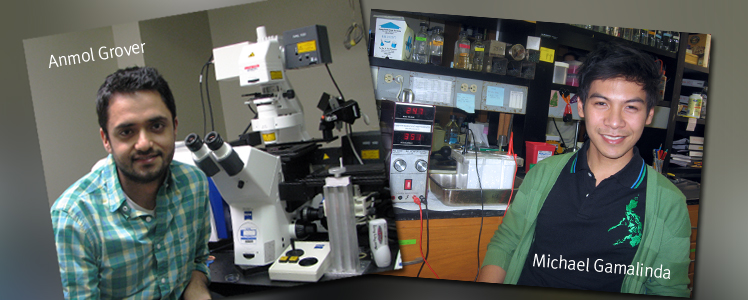Wednesday, February 27, 2013

De Vries & Stupakoff Fellowships
Ph.D. candidates, Michael Gamalinda and Anmol Grover, were named the 2013 de Vries and Stupakoff Fellowship recipients for the impact and quality of their recent publications.
Gamalinda, a fourth-year student in the Woolford lab, received the de Vries Fellowship for “Yeast polypeptide exit tunnel ribosomal proteins L17, L35 and L37 are necessary to recruit late-assembling factors required for 27SB pre-RNA processing” published in Nucleic Acids Research, and “Saccharomyces cerevisiae ribosomal protein L26 is not essential for ribosome assembly and function” published in Molecular and Cellular Biology.
Gamalinda’s work focuses on elucidating the roles of ribosomal proteins in eukaryotic ribosome assembly in vivo. Ribosomes are arguably the most complex nanomachines in nature, catalyzing the essential process of translation. In yeast, their biogenesis involves the transcription, processing, and folding of four ribosomal RNA (rRNA) species, as well as the regulated assembly of roughly 80 ribosomal proteins. Little is understood about how ribosomal proteins facilitate ribosome construction in living cells, so Gamalinda initially centered his studies on the four yeast ribosomal proteins, L26, L17, L35, and L37, surrounding the nascent peptide exit tunnel of the large ribosomal subunit. His work showed that these ribosomal proteins in this functional neighborhood are important for an intermediate pre-rRNA processing step in the ITS2 spacer sequence by recruiting key trans-acting factors required to trigger this event. Nucleocytoplasmic export of mutant nascent ribosomes lacking these ribosomal proteins is impaired, and in most cases, targeted for degradation.
Unanticipated observations about eukaryotic ribosome assembly were also revealed by Gamalinda’s studies. First, the bacterial homologue of yeast ribosomal protein L26 is a primary initiator of large subunit assembly. However, L26 is not essential for production of 60S subunits in yeast, although L26 modestly facilitates biogenesis efficiency. Second, mature ribosomes produced in the absence of L26 could properly engage in translation, despite differences in rRNA structure folding relative to wildtype. Third, failure to process the ITS2 spacer sequence is not directly due to changes in ITS2 structure. Finally, the polypeptide exit tunnel region appears to be resilient to local perturbations, suggesting that this environment is buffered against the absence of ribosomal proteins and inherently flexible.
Gamalinda’s studies were among the earliest to attempt to understand in more detail the roles of ribosomal proteins in eukaryotic 60S assembly in vivo, by investigating their function in recruiting assembly factors and ribosomal proteins into pre-ribosomes. Investigating this group of ribosomal proteins, especially L26, was also a first step in explaining potential differences between bacterial and eukaryotic ribosomal subunit biogenesis. Furthermore, these are the first studies to examine rRNA structural changes in vivo, in ribosomal protein mutants.
Since publishing his findings, Gamalinda has systemically examined a wider set of ribosomal proteins that are implicated in different stages of pre-rRNA processing. An exciting model for tiered construction of large subunit domains has emerged from investigating their function in assembly of other proteins. He is now beginning to study the roles of eukaryotic specific protein elements in the formation of large ribosomal subunits.
Additionally, Anmol Grover, a sixth-year in the Bruchez lab, received the Semon H. Stupakoff Fellowship for another unprecedented scientific paper published in Angewandte International Chemie entitled “Genetically encoded pH sensor for tracking surface proteins through endocytosis.” This paper was also chosen as the editor’s pick for a “Hot Paper” and was selected for the Frontispiece.
Grover helped develop a new, genetically encoded ratiometric pH biosensor that selectively labels cell surface protein and monitors its agonist-dependent internalization. The biosensor consists of a fluorescence resonance energy transfer (FRET) based dye, TOI-Cy5 analogue that becomes activated when binding to its cognate fluorogen activating peptide and emits pH dependent ratiometric signal. Solution spectroscopy was performed on the dye-protein complex to establish its ratiometric signature in response to pH change in vitro. Furthermore, Grover used the biosensor to label β2-adrenergic receptors in fibroblast cells and investigated the biosensor’s performance as the labeled receptor is internalized. Since the tandem dye is not cell permeable, it selectively labels cell surface receptors, thereby giving them a unique advantage of distinguishing them from the entire cellular pool and tracking their endocytic and recycling route at spatial and temporal resolution. The biosensor was used as a surrogate antigen to reveal direct surface-to-endosome antigen transfer between dendritic cells elucidating the cross dressing mechanism of immune response amplification.
Unlike direct fluorescent labeling, the fluorogen biosensor dye binds at nanomolar concentrations, gives higher signal to background activations and does not have to be washed away to reduce the background signal. These advantages have spurred the development of newer genetically targeted biosensors based on similar principles.
After publishing his research, Grover is now aiming to establish a novel method to fluorescently label eukaryotic ribosomes. Eukaryotic ribosomes have not been labeled before due to higher structural and functional complexity compared to prokaryotic ribosomes. As a result, biophysical studies on eukaryotic translation are impossible. Therefore, labeling eukaryotic ribosomes non-invasively with bright fluorophores in a site-specific manner would be a powerful tool in investigating frame shifting, tRNA selection and ribosome biogenesis. In Grover’s particular case, he wants to label eukaryotic ribosomes, in order to make measurements on translation kinetics and rates of co-translational folding as well as find correlations between them.
Congratulations to both awardees.
The de Vries Fellowship was made possible through the generosity of alumnus and founder of Medidata Solutions, Glen de Vries. The Semon H. Stupakoff Fellowship was named after alumnus Semon Stupakoff.